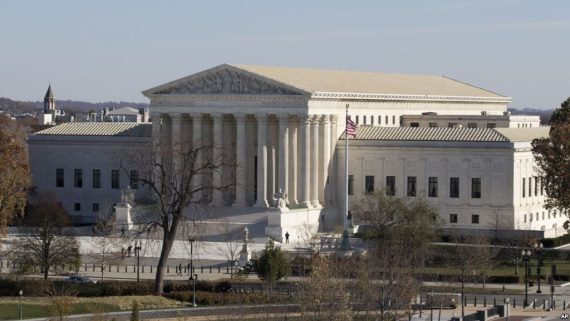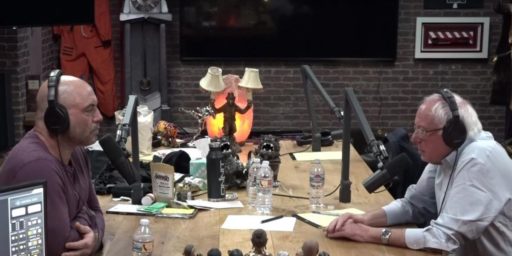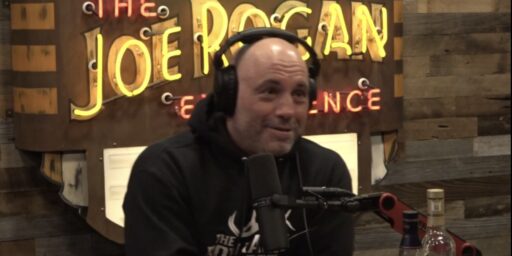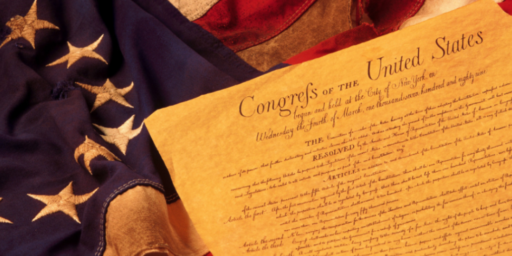Supreme Court Mulls Whether States Can Ban ‘Political’ Apparel At Polling Places
Yesterday, the Supreme Court heard oral argument in a case pitting the First Amendment against the right of states to regulate elections.
Yesterday, the Supreme Court heard oral argument in a case out of Minnesota concerning that state’s ban on “political apparel” at polling places, a case that pits the First Amendment against the state’s authority to maintain the integrity of the election process:
WASHINGTON — Minnesota prohibits people at polling places from wearing T-shirts, hats and buttons that express political views. In a First Amendment challenge to the state’s law on Wednesday, the Supreme Court explored what kinds of apparel the law bars as the justices considered how to balance free speech rights with civility at the voting booth.
Justice Samuel A. Alito Jr. peppered a lawyer for the state with hard questions during a lively argument.
A T-shirt bearing a rainbow flag?
“It would be permitted,” said the lawyer, Daniel Rogan, “unless there was an issue on the ballot that related somehow to gay rights.”
A T-shirt saying “Parkland Strong,” referring to the Florida school shooting?
That would be O.K., Mr. Rogan said.
A T-shirt bearing the logo of the National Rifle Association?
That would not be acceptable “today in Minnesota,” Mr. Rogan said.
One reproducing the text of the Second Amendment?
“I think that that could be viewed as political,” Mr. Rogan said.
One reproducing the text of the First Amendment?
“It would be allowed,” Mr. Rogan said.
One saying “All lives matter”?
“That could be perceived as political,” Mr. Rogan said.
One saying #MeToo?
“If that was an issue in elections in that polling place, that would be political,” Mr. Rogan said.
After hearing all of this, Justice Neil M. Gorsuch said he was uneasy about a law that “would forbid people from wearing certain portions of the Bill of Rights into a polling place but not other portions of the Bill of Rights.”
The case, Minnesota Voters Alliance v. Mansky, No. 16-1435, presented the court with unusually difficult line-drawing challenges. But several of the more liberal justices, joined at times by Chief Justice John G. Roberts Jr. and Justice Anthony M. Kennedy, said that maintaining the decorum and dignity of polling places could justify substantial restrictions on free speech rights.
“You should be able to have a time for some quiet reflection, or to do that important civic obligation in peace and quiet, without being bombarded by another campaign display,” Chief Justice Roberts said.
J. David Breemer, a lawyer for the challengers, disagreed. “Polling places are not pristine retreats from the real world,” he said.
But Justice Kennedy seemed to accept that polling places may require special First Amendment rules. “Why should there be any speech there at all?” he asked. “You’re there to vote.”
Minnesota’s law, similar to ones in about nine other states, is quite broad. It says that “a political badge, political button or other political insignia may not be worn at or about a polling place on primary or Election Day.”
The case started when members of the Minnesota Voters Alliance, which says it works to ensure “election integrity,” turned up at Minnesota polling places wearing T-shirts bearing Tea Party logos and buttons saying “Please I.D. Me.”
They were told to cover the messages and were allowed to vote even if they refused. But they risked prosecution for disobeying poll workers’ orders.
Justice Sonia Sotomayor said the “Please I.D. Me” buttons were particularly objectionable, adding that they conveyed “a highly charged political message” that a lower court had found “was intended to intimidate people to leave the polling booth.”
The Supreme Court case was not centered on the particular items the challengers wanted to wear. It was instead a general challenge to the law, saying it is overly broad and vague even if the particular items could constitutionally be barred.
Minnesota’s law, similar to ones in about nine other states, is quite broad. It says that “a political badge, political button or other political insignia may not be worn at or about a polling place on primary or Election Day.”
The case started when members of the Minnesota Voters Alliance, which says it works to ensure “election integrity,” turned up at Minnesota polling places wearing T-shirts bearing Tea Party logos and buttons saying “Please I.D. Me.”
They were told to cover the messages and were allowed to vote even if they refused. But they risked prosecution for disobeying poll workers’ orders.
Justice Sonia Sotomayor said the “Please I.D. Me” buttons were particularly objectionable, adding that they conveyed “a highly charged political message” that a lower court had found “was intended to intimidate people to leave the polling booth.”
The Supreme Court case was not centered on the particular items the challengers wanted to wear. It was instead a general challenge to the law, saying it is overly broad and vague even if the particular items could constitutionally be barred.
Mr. Breemer, representing the challengers, seemed to frustrate the justices with his refusal to say exactly where he would draw the line.
“We’re going to have to write an opinion on this,” Justice Kennedy told him. “You say: ‘Well, I don’t know. I don’t know.’ “
Amy Howe summarizes the argument:
Several common and related concerns emerged among the justices who seemed inclined to strike down the law. The first was whether there is actually any need for the law – or, put another way, whether allowing “political” apparel will really be disruptive at the polls. Justice Samuel Alito, perhaps the challengers’ strongest supporter, asked attorney David Breemer, who represents Cilek and the MVA, to describe what has happened in the approximately 40 states that do not have similar laws. Are there brawls in polling places, Alito queried?
Justice Neil Gorsuch asked Daniel Rogan, the assistant county attorney who defended the law, a similar question. Gorsuch suggested that Minnesota’s law is an outlier. Is there any documented need, he asked, for the law to go so far? What is the state’s compelling interest in barring so many kinds of apparel?
Justice Stephen Breyer appeared more convinced that the state has a compelling reason for the law. Breyer told Breemer that the state is simply trying to carve out somewhere for voters to have a moment for thought and reflection before they cast a ballot.
Chief Justice John Roberts at one point echoed this sentiment, telling Breemer that apparel can convey fairly strong messages – the proverbial “a picture is worth a thousand words.” Couldn’t the state decide, he asked, that it wants the polling places to be a peaceful and quiet respite from a long and bitter campaign?
But Justice Elena Kagan was skeptical. There are clearly some places, she told Rogan, where we don’t want anyone wearing buttons with political messages – for example, a courtroom. But why is a polling place, which she described as the culmination of a “rowdy political process,” such a place?
Roberts seemed more sympathetic to the challengers on another point – the possibility that the Minnesota law goes too far, banning apparel that will not have any tangible effect on decorum (or voters) at the polls. Do you really think, he asked Rogan, that a very small pin bearing a campaign logo is going to affect the atmosphere in the polling place?
Rogan responded that such a pin would indeed have a negative effect, including by possibly intimidating voters who don’t share the views of the person wearing the pin.
Roberts pushed back, telling Rogan that he didn’t understand where any disruption or harm to decorum at the polling place would come from. When they go to vote, Roberts stressed, people don’t really believe that they will be protected from learning what others think.
Justice Sonia Sotomayor saw things differently, however. She noted that Cilek was wearing a “Please I.D. Me” button when he went to the polls. That message, she emphasized, is a highly charged political one, intended to influence other voters to leave the polls.
(…)
By the end of an hour of oral argument, it was hard to call the decision for one side or the other. As a general rule, the justices are often fairly protective of free speech – even when it is speech with which they may strongly disagree. The combination of that protectiveness and the difficulty of drawing a line between apparel that is or is not “political” may bode well for the challengers in the long run, but we likely will not know for sure for several months.
As things stand, there are two obvious issues that the Justices will have to deal with here, and it’s hard to tell exactly where they will come down in the end.
On the one hand, obviously, is the First Amendment issue and the idea that the law in question seems like an obvious content-based regulation on speech. As a general rule, the Supreme Court, in general, has been skeptical of nearly any content-based restriction on speech, and this is especially true when it comes to political speech such as some of the examples that were tossed around during today’s oral argument. That has been especially true of this Court in particular, which despite having a conservative reputation, has been strongly united in opposition to nearly any content-based restriction on the First Amendment. This can especially be seen in recent cases. For example, in recent years, the Court has set aside a civil verdict against the Westboro Baptist Church on the ground that even offensive speech is protected by the First Amendment, struck down a law that made it a crime to falsely claim military honors, struck down a California law restricting the sale of “violent” video games, allowed a suit against an Ohio law banning “false” campaign speech to go forward, and struck down a Massachusetts law establishing a protest buffer zone around abortion clinics. On the specific issue of political speech, the Court has if anything been even more emphatic in its position disfavoring restrictions on speech. Specifically, in cases such as Citizens United v. FEC and McCutcheon v. FEC in which it clearly sided with the right of parties to engage in political speech over the power of the state to regulate or even ban that speech in the name of some vague notion of public integrity.
On the other side of the ledger, there is the question of the ability of states and localities to maintain the integrity of the election process. For many states, that includes laws that prohibit “electioneering” within a certain distance from a polling place. In some states, such as Minnesota, that ban on electioneering includes regulations that restrict what a voter can wear when they go to vote. In many cases, these laws have been applied in bizarre and often contradictory ways. For example, while it would seem clear that a ban on apparel that specifically mentions a candidate or issues on the ballot would probably be appropriate, it’s hard to see how someone wearing a shirt, button, or ballcap that contains a message that, while potentially political, does not directly refer to a candidate or issue on the ballot in a particular can be considered inappropriate. This can best be seen in the responses of the attorney who argued the case for Minnesota answered some of the hypotheticals that the Justices put before him. It’s hard to see, for example, how a shirt that contains the language of the First Amendment would be considered acceptable, but one that contains the text of the Second Amendment would not be absent a situation where some kind of gun measure was on the ballot. In fact, the responses to the hypothetical questions reveals the real danger of the kind of law that Minnesota has, which is the fact that there’s a serious danger that it could be applied in an arbitrary fashion from polling place to polling place and would depend in no small part on the political biases of the election officials charged with enforcing the law and running the polling place.
Given the difficulty of drawing a clear line on when apparel at the polling place would be acceptable and when it would not be, the natural implication is that the Justices would be inclined to strike down the law entirely. At the same time, though, it’s clear from the transcript that the Justices also recognize the interest the state has in maintaining the orderly operations of elections, something that has traditionally been seen to include at least some regulation of “electioneering” at the polling place. Given that, it’s unclear how eager a majority of the Justices would be to strike the law down completely. In any case, we’re likely going to have to wait until June for the decision in this case. In the meantime, if you’re interested in reading the pleadings that have been filed in this case, you can find them, as always, at SCOTUSBlog’s information page for this case.
Here’s the transcript of the oral argument:
Minnesota Voters Allianec v. Mansky Et Al by Doug Mataconis on Scribd






But RUSSIA!!!
Just wanted to throw that out there for teve tory and Daryl’s brother.
#HAND
Voting is not speech???
Much ado about nothing. People will not vote differently when they spy a t-shirt in the school gym. Just vote already.
@Mister Bluster:
I didn’t address it in the post, but that was my thought too!
@John Peabody:
I tend to agree. I don’t mind regulation of in-person electioneering within a certain distance of a polling place, but the idea that clothing is going to be something that changes someone’s mind is kind of silly.
If I can wear a T-shirt with my party’s name or – say – just a stylized donkey on it into the polling place, can I not also carry a sign? If a sign, can I not carry a loud speaker with recorded message?
I’m pretty far on the side of 1st Amendment absolutism but jurisdictions surely can control the atmosphere in their polling places.
If we allow political messages on apparel, on what grounds do we ban hand carried political signs? If we allow hand carried signs, why not signs on posts. If signs on posts, why not billboards? If billboards, why not sound trucks? If sound trucks why not big screens and political ads?
Which isn’t really my argument. You can write a slippery slope argument about anything. My argument is that whatever the Supremes decide, there will still be lines, so the difficulty of drawing lines is a bogus argument. The State of Minnesota already drew a line, they enforced it in a reasonable way against a group of RWNJ provocateurs, what problem are we solving here?
I earlier commented on James’ LaPenn post that while France is too restrictive of speech, we don’t get it right either. This post, and Doug’s list of recent decisions on speech, support my case. When I took Jr. High Civics, back before dirt, I was taught that freedom of speech meant the government couldn’t punish me for saying things the government didn’t like. Nobody said the richest people could monopolize political speech nor that speech could not be subject to sensible restrictions.
Who would decide what goes and what doesn’t? What is the criteria or do they just make it up as they go?
Would a US flag cap or shirt be ok? How about “Live Free or Die”
“These colors don’t run”? (the amazing Charlie Daniels)